Design and performance study of a gas-Cherenkov detector with an off-axis parabolic reflector for inertial confinement fusion experiments
Zifeng SONG (宋仔峰), Bin ZHU (朱斌), Yunqing XIAO (肖云青),Tao XU (徐濤), Zhongjie LIU (劉中杰), Yuchi WU (吳玉遲),Xiayu ZHAN (詹夏宇), Tao YI (易濤), Jiabin CHEN (陳家斌) and Qi TANG (唐琦)
1 Laser Fusion Research Center, China Academy of Engineering Physics, Mianyang 621900, People’s Republic of China
2 Science and Technology on Plasma Physics Laboratory, Laser Fusion Research Center, China Academy of Engineering Physics, Mianyang 621900, People’s Republic of China
Abstract In this work, the gas-Cherenkov detector with an off-axis parabolic reflector (OprGCD) is designed using the Geant4 Monte Carlo simulation toolkit,which is helpful to improve the collection efficiency of Cherenkov photons.The method to study the performance of OprGCD based on femtosecond laser-wakefield-accelerated electron beams is presented.Cherenkov signals with high signal-to-noise ratio were obtained, and the measured Cherenkov signals changing with the CO2 pressure were consistent well with the simulation results.The design and study of this OprGCD system lay the foundation for the application of fusion gamma diagnostics system in large laser facilities of China.
Keywords: fusion gamma, Cherenkov detector, Monte Carlo simulation, laser-wakefieldaccelerated electron
1.Introduction
The temporal evolution of fusion reaction is helpful in furthering our physics understanding of inertial confinement fusion (ICF) implosions and capsule performance.The duration of the fusion burn is a sensitive indicator of the effective laser-target coupling, and it provides a timeresolved description of the fundamental physical reactions and a valuable parameter for modeling the implosion during the ICF experiments [1, 2].In the laser driven implosion experiments, deuterium-tritium (DT) fusion gamma ray,in addition to fusion neutron and charged particle, is an important diagnostic method that provides important information about fusion burn and the imploded capsule conditions.Compared with fusion neutron, fusion gamma is useful to measure the time profile of the DT fusion burn since it has no the Doppler induced time-of-flight broadening and the down-scattering phenomenon [3-5].Compared with a neutron temporal diagnostic system [6, 7],fusion gamma rays can improve the accuracy of fusion reaction history under the implosion background of strong radiation.DT fusion gamma rays are preferred over neutrons for measuring the fusion burn duration in ICF implosion experiments.The characteristic parameters of implosion,such as fusion reaction history, bangtime, ablator areal density and hydrodynamical mixing, can be determined by measuring the gamma rays produced during ICF implosions,and gamma-based measurement is an important method for evaluating the implosion performance in ICF experiments [8, 9].
In ICF implosion experiments, the intensity of the complex activated gamma rays generated by DT fusion neutrons is several orders of magnitude greater than that of fusion gammas [10, 11].The gas-Cherenkov detector (GCD) is an ideal choice for measuring fusion gamma rays, because the threshold energy producing Cherenkov radiation can be adjusted conveniently and flexibly by changing the gas medium pressure in order to eliminate background disturbances [12, 13].GCD can detect high-energy fusion gamma rays while remaining insensitive to neutrons and lowenergy neutron-induced gamma rays.Two Cherenkov detectors, the compact GCD and the multi-channel gamma reaction history (GRH), have been developed by Berggrenet al[14], Maloneet al[15] and Herrmannet al[16, 17] for measuring multiple-energy gamma-rays produced during DT implosions at the National Ignition Facility (NIF).The compact GCD used two parabolic reflectors to collect the Cherenkov photons, and a centered tungsten shielding to prevent DT gamma rays from entering the high-speed photon detector directly.The GRH used three 90°off-axis parabolic reflectors to collect the Cherenkov photons, which was better to improve the gamma sensitivity over GCD based on the nonimaging optical system [15, 18].Liuet al[19] proposed a global optimization method combining a genetic algorithm with Monte Carlo simulation to design GCD and GRH for ICF diagnosis.The efficiencies of GCD and GRH optimized by this method were improved by about 20% and 76%,respectively,higher than the results obtained by the traditional optical ray-tracing method.In addition, Moran proposed another design idea of GCD named as threshold Cherenkov detector in 1984 [20], in order to measure DT fusion gamma in fusion diagnostic gamma experiment.This threshold Cherenkov detector provided the photon detector outside the Cherenkov generating paths for better shielding, and had the advantages of its simplicity and high sensitivity based on a single parabolic reflector.In this paper, a GCD with an offaxis parabolic reflector (OprGCD) is designed in detail to obtain high gamma sensitivity, and performance study of OprGCD is introduced.The optimized detector structure, the spatial distribution of photon trajectory and the temporal dispersion of collected Cherenkov photons are given by the Geant4 Monte Carlo simulation toolkit, and the signal-tonoise ratio (SNR) of this diagnostic system is analyzed.Performance study of OprGCD was conducted by using femtosecond laser-wakefield-accelerated electron beams, and Cherenkov signals with high SNR were obtained.The measured Cherenkov signals changing with the CO2pressure were consistent well with the simulation results.The design and study of this OprGCD system are helpful to develop the fusion gamma diagnostic technique in implosion experiments at large laser facilities of China.
2.Measuring principle
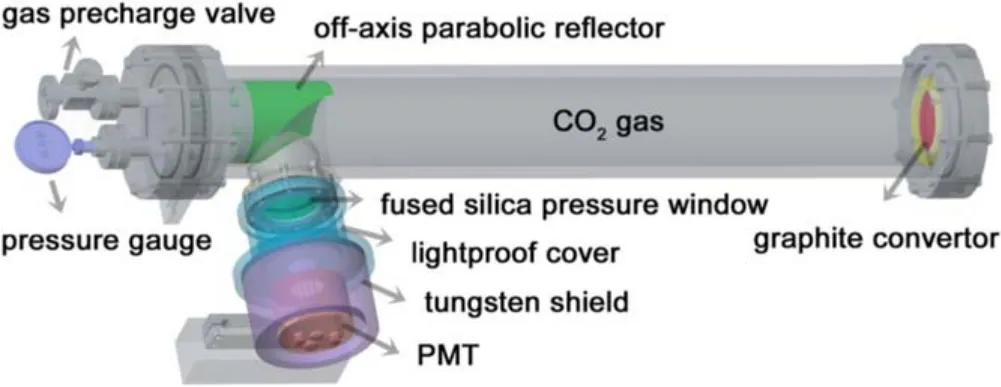
Figure 1.Structure of a gas-Cherenkov detector with an off-axis parabolic reflector.
GCD is generally composed of gamma convertor, gaseous Cherenkov radiation medium, optical collection system and photon recording subassembly.The low-Zmaterial converts fusion gamma rays to initial electrons with angular distribution by Compton scattering and pair production, and secondary Cherenkov photons are produced by the emitted electrons traveling faster than light in the radiation medium,whose angles are once more spreading relative to the original electron trajectories.The threshold energy of generating Cherenkov photons is related to the refractive index of the radiation medium, and the refraction index minus one is proportional to the density and hence the gas pressure at the same temperature.In order to detect the fusion gamma rays accurately in a strong neutron-induced gamma radiation environment,adjustment of gas pressure resulting in a change of the threshold energy is used to discriminate against lower energy gamma rays.Gaseous radiation medium used is carbon dioxide gas with a maximum pressure of 10 atmospheres,and the threshold energy is as low as 4.9 MeV.The Cherenkov photons generated in the radiation medium are gathered by an off-axis parabolic reflector inside of the gas cell and are subsequently focused onto a fast photomultiplier tube(PMT)outside of the gas cell.A pulse current signal is output to the high bandwidth oscilloscope for recording, which carries the time history information of primary gamma rays by unfolding the temporal response of this detection system in a deconvolution analysis method.The amplitude of this current signal reflects the intensity of primary gamma rays after the system has been calibrated.The structure of OprGCD is shown in figure 1.The single off-axis parabolic reflector has relatively higher photon collection efficiency (defined as the ratio of detected Cherenkov photons by the PMT to photons reaching the optical receiving surface) than multi-mirrors used in GCD or GRH system.The Cherenkov photons gathered by the off-axis parabolic reflector are ejected via the fused silica pressure window on the side of the gas cell and then are focused on the receiving area of PMT.
3.System design and signal evaluation
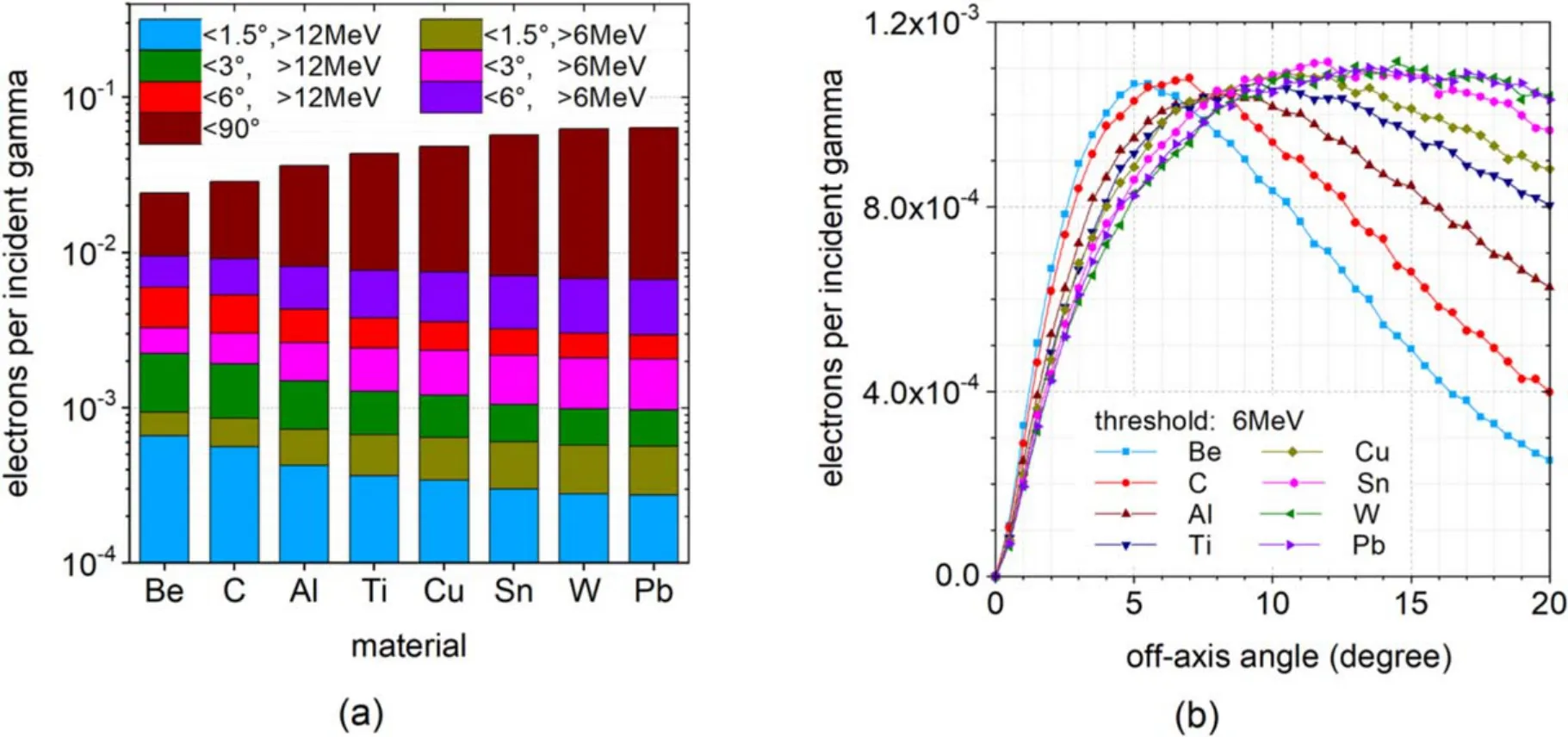
Figure 2.(a) Calculated electron conversion efficiency for various convertor materials.(b) Calculated angular distribution of outcoming electrons with 0.5° bin for various materials at a 6 MeV threshold energy.
DT fusion gamma rays produce Compton electrons in the low-Zgamma convertor, and the emitted electrons are angularly distributed.A convertor material which provides the larger number of high energy electrons within smaller offaxis angles is the best chosen.It can give a higher probability of subsequent Cherenkov photons to be gathered by the offaxis parabolic reflector with the specific angular acceptance.Several materials had to be investigated and simulated by Geant4 Monte Carlo toolkit in version of 10.1[21]in order to optimize the conversion efficiency.The electromagnetic physics process used in the simulation code was chosen as a low energy interaction model of the G4EmLivermorePhysics package.A beam of 16.7 MeV gamma rays impinged on each material isotropically,and the linear density of each convertor material was 3 g cm?2.The conversion efficiency of electrons(outcoming electrons per incident gamma on the convertor)above threshold energy and the angular distribution of electrons that emerge from the convertor surface are shown in figures 2(a)and(b),respectively.These results are consistent with the simulation results of CYLTRAN studied by Herrmannet al[22].Beryllium is the best convertor material which has high electron conversion efficiency at the small offaxis angle, and carbon is the next.According to the calculation results with respect to the gamma-electron conversion efficiency curves in [23], 15 mm thick carbon material was selected as the gamma convertor.
In the gaseous radiation medium, these outcoming electrons excite Cherenkov photons which are also angularly distributed.The Cherenkov photons are generated along the trajectory of outcoming electrons those travel through the carbon dioxide gas.The quantity of Cherenkov photons produced in the radiation medium correlates positively with the gas cell length.However,for a specific angular acceptance of the collection optics,some photons cannot reach the optical receiving surface at the end of the gas cell due to excessive off-axis angle.In order to increase the number of Cherenkov photons reaching the optical receiving surface, an OprGCD simulation model was built using the Geant4 Monte Carlo toolkit to simulate the whole physical process of gammaelectron-Cherenkov photon.Considering the restriction of solid angle for installation in the target chamber, a gamma convertor with a diameter of 9 cm and a gas cell with a diameter of 11 cm were selected.Under the threshold energy of 6 MeV, the angular distribution of Cherenkov photons reaching the end of the gas cell at different gas cell lengths is shown in figure 3(a).Cherenkov photons per incident gamma at an off-axis angle interval of 0.5° are numbered independently.Meanwhile, the efficiency curves for Cherenkov photons within off-axis angles of 3°,6°and 12°are shown in figure 3(b).The photon conversion efficiency is defined as the ratio of Cherenkov photons reaching the optical receiving surface to incident gammas on the convertor.To contrast the photon conversion efficiency conveniently, the two sets of data with an off-axis angle of less than 3°or 6°are multiplied by 3.5 or 1.5, respectively.In the Cherenkov photons reaching the optical receiving surface, photons within an offaxis angle of 12° account for more than 80% of the total number.As the gas cell length increases, the Cherenkov photons reaching the end of the gas cell tend to accumulate within smaller off-axis angles.A gas cell with a length of about 80 cm is suitable for use in OprGCD in order to increase the number of Cherenkov photons within smaller offaxis angles, which is favorable for the efficient collection of Cherenkov photons by the off-axis parabolic reflector in limited spaces.
The Cherenkov photons produced in the radiation medium are gathered and collected by the off-axis parabolic reflector.The off-axis parabolic reflector is designed based on the spatial distribution of Cherenkov photons to improve its photon collection efficiency (defined as the ratio of detected Cherenkov photons by the PMT to photons reaching the optical receiving surface).At an electron threshold energy of 6 MeV, the simulated spatial distribution of Cherenkov photons drawn by a numeric computation software Matlab is shown in figure 4(a).In the figure, theZaxis is along the length of the OprGCD gas cell,and theXaxis andYaxis are along the radial direction of the OprGCD gas cell.In the simulation, Cherenkov photons reaching the end of the gas cell within an off-axis angle of 12° are recorded.It can be observed that few Cherenkov photons are produced near the center axis of the gas cell,and the Cherenkov photons that are produced within an off-axis angle of 12° and that reach the end of the gas cell are mainly concentrated in the outer ring.The temporal response of OprGCD is also related to the spatial distribution of produced photons.For different pressures of carbon dioxide, the temporal discretization of Cherenkov photons reaching the off-axis parabolic reflector within an off-axis angle of 12°is shown in figure 4(b).In this figure,t0is the time of peak photon arrival at the off-axis parabolic reflector, and the time interval of 20 ps is added sequentially for each gas pressure in order to contrast the temporal discretization conveniently.The full width at half maximum(FWHM) for the temporal discretization of Cherenkov photons collected at different gas pressures is less than 15 ps.

Figure 3.(a) Calculated angular distribution of Cherenkov photons for various gas cell lengths at a 6 MeV threshold energy.(b) The calculated conversion efficiency of Cherenkov photons depending on the gas cell length under different off-axis angles.

Figure 4.(a) Simulated spatial distribution of Cherenkov photons at a length interval of 10 cm.(b) Simulated temporal discretization of collected Cherenkov photons for various gas pressures.

Figure 5.(a) Simulated wavelength distribution of Cherenkov photon at a 6 MeV threshold energy.(b) Schematic of one typical simulated photon collection instance in the LightTools simulation model.
The design of the off-axis parabolic reflector is also related to the wavelength distribution of collection photons.At a 6 MeV threshold energy, the wavelength distribution of Cherenkov photons reaching the end of the gas cell within an off-axis angle of 12° is simulated, as shown in figure 5(a).These results are basically consistent with the calculation results studied by Iodiceet al[24].The simulated Cherenkov photons are mainly concentrated within the range of 200-600 nm and the number of photons in the ultraviolet light spectrum accounts for more than 60% of the total number of photons.Therefore,a coated off-axis parabolic reflector needs to be selected to increase the short-wavelength photon reflectivity.Generally, the photon collection efficiency will decrease by using more reflectors in the optical design process.The 90°off-axis optical structure can provide the photon detector outside the Cherenkov generating paths for better shielding.In the optical design, the spatial distribution and wavelength distribution of Cherenkov photons are the main issues of consideration.The suitable focal length of the reflector is chosen to balance the acceptance angle of photons and the size of photon receiving surface.A simulation model was built using optical tracing software LightTools to design the off-axis parabolic reflector and simulate the collection process of Cherenkov photons.An iterative approach was taken in the optical design process to obtain the optimal structure.According to the optical simulation results, the 90°off-axis parabolic reflector manufactured by Edmund Optics Company with a model of 35 592 was selected and used as the off-axis parabolic reflector.This 90° off-axis parabolic reflector has an effective focal length of 152.4 mm, and the surface has an aluminum-coated film with roughness of less than 10 nm for increasing photon reflectivity.The reflectivity of this off-axis parabolic reflector for photons within the range of 300-700 nm is higher than 85%.The simplified spatial distribution of photons at different locations was input into the simulation model for the calculation of photon collection efficiency.The schematic of one typical simulated photon collection instance by Edmund 35 592 is shown in figure 5(b).The center of the photon receiving surface is located at a 152.4 mm distance from the center of the off-axis parabolic reflector.In the simulation instance shown in figure 5(b),Cherenkov photons emit from a hollow ring with an inner diameter of 15 mm and an outer diameter of 20 mm,and the initial photon angles are less than 6°.The Cherenkov photons are reflected by this reflector and gathered onto the receiving surface with a diameter of 10 mm.The diameter of the masking aperture located at an 85 mm distance from the center of the parabolic reflector is 50 mm.By integrating the optical simulation results of all photon radial rings in the gas cell,the photon collection efficiency of this off-axis parabolic reflector is about 40%.
In the optimal design of OprGCD, the detector consists of a sealed cavity of 80 cm long and a diameter of 11 cm filled with CO2gas, and a 15 mm thick carbon convertor with a diameter of 9 cm in the front.A 90° off-axis parabolic reflector with an effective focal length of 152.4 mm is used to collect the Cherenkov photons within 12°off-axis angle.The fast PHOTEK PMT110 tube with a 10 mm diameter photocathode is chosen to record the gathered Cherenkov photons.As the simulation results,the photon conversion efficiency of OprGCD is 1.80 photons per incident gamma at a 6 MeV threshold energy,and the photon collection efficiency is about 0.4.Therefore, the detector sensitivity (defined as detected Cherenkov photons per incident gamma on the convertor) is about 0.72 photons per incident gamma at a 6 MeV threshold energy.OprGCD has higher detector sensitivity than GCD(0.12 photons per incident gamma[5,25]or 0.16 photons per incident gamma after the optimization design by Liuet al[19]at a 6.3 MeV threshold energy) or GRH (about 0.21 photons per incident gamma [26] at a 5 MeV threshold energy and about 0.28 photons per incident gamma [27] at a 4.5 MeV threshold energy, or about 0.39 photons per incident gamma after the optimization design by Liuet al[19] at a 5 MeV threshold energy)on the NIF.As the velocities of outcoming electrons traveling in the gas cell are near the speed of light in a vacuum, the intrinsic temporal dispersion (left the PMT response out of consideration) of OprGCD is estimated as 15 ps approximately.OprGCD has a temporal response of about 110 ps by taking the 100 ps response of PMT110 tube into consideration.
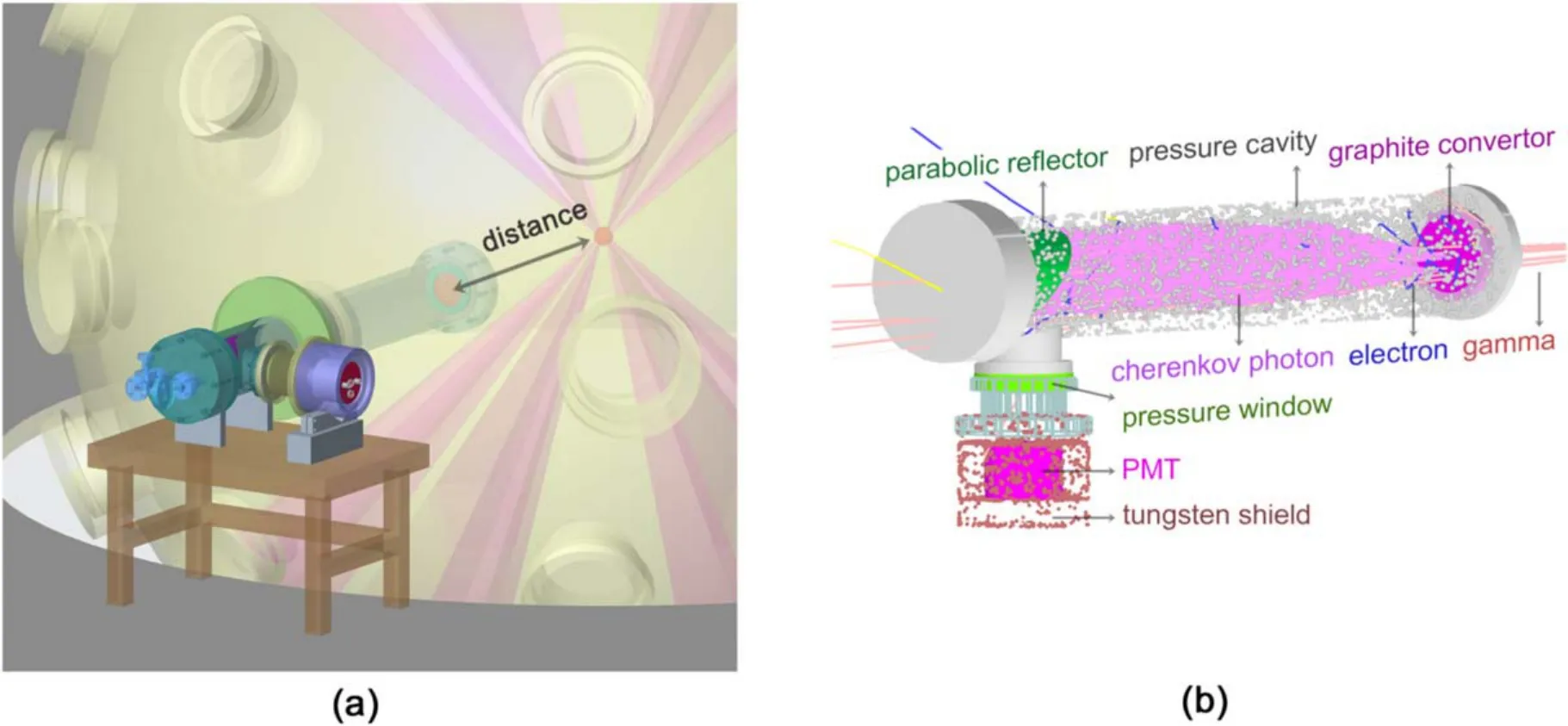
Figure 6.(a) Schematic of Cherenkov system installation.(b) System SNR evaluation and simulation model.
For the implosion experiments at the large laser facilities of China, OprGCD will be installed onto the flange of the target chamber, and the front-end gamma convertor can be inserted into the target chamber,as shown in figure 6(a).The 90°off-axis structure can effectively prevent primary gamma rays or conversion electrons from entering the fused silica pressure window directly.However, some electrons scattered from the pressure cavity and parabolic reflector will excite Cherenkov photons in the fused silica pressure window on the side, thus interfering with the main photons signal that produced in the gaseous radiation medium.These scattered electrons may also generate interference signals by directly enter the PMT on the side.Cherenkov photons generated in the off-axis parabolic reflector (refractive index of 1.5 corresponds to threshold energy of 175 keV) have no effect on the main signal of interest, because these photons cannot be reflected into the PMT.The SNR of OprGCD was evaluated by using the Monte Carlo simulation code.The simulation model drawn by OpenGL visualization driver in the Geant4 toolkit [28] is shown in figure 6(b).In the simulation,16.7 MeV gamma rays from isotropic point source impinged on the graphite convertor at a 60 cm distance from the source.The PMT was coated with a 12 cm thick tungsten shield,and it prevented the DT fusion gamma from entering the PMT directly by five orders of magnitude.When the CO2gas pressure is set to 10 atm,the SNR of OprGCD is estimated as about 100:1 calculated by the simulation.In the ICF implosion experiments with DT neutron yield higher than 1012,more than 500 electrons will be detected and more than 104Cherenkov photons will be recorded by OprGCD located at a 60 cm distance from the source.As OprGCD is installed on the laser facility with larger chamber,the higher neutron yield is required to detect fusion gamma rays in an implosion,which is inversely proportional to the solid angle of OprGCD.
4.Experiment results and analysis
Laser wakefield has extremely high acceleration gradient and can generate high-energy electron beam over an extremely short acceleration distance [29].Currently, the electron beam accelerated by laser wakefield has a pulse width of femtosecond level, with energy up to tens of MeV and divergence angle within several milli-radians [30].Thus, it has a great advantage in measuring Cherenkov signals with high temporal response.In order to study sensitivity and background,an performance test of OprGCD was conducted by using the femtosecond laser-wakefield-accelerated electron beams generated by SILEX-I Ti:sapphire laser system [31].The schematic of the experimental arrangement and the experimental configuration in site is shown in figure 7(a).In the testing experiments, the gas cell axis of OprGCD was located along the axis line of electron beams, and the frontend sealing window made of 5 mm thick aluminum alloy was located about 10 cm from the electron source.The laser beams with pulse width of 25 fs were focused on the front edge of a supersonic nitrogen gas jet boundary at a height of 1 mm.The waist width of the focal spot was 8 microns approximately, and the average power density of focused laser beams was 1.6 × 1019W cm?2.The energy spectra of the electron beams ejected from the gas jet were measured using a diagonal radioactive zone(DRZ)phosphor screen and a permanent magnet before the OprGCD installation.The permanent magnet can disperse the electrons according to their different kinetic energies at different positions on the DRZ screen.The typical energy spectrum of laser wakefieldaccelerated electron beam is shown in figure 7(b).
During the performance test of OprGCD, the CO2gas pressure was set to 10 atm and the high voltage applied in the PMT240 PMT was ?2300 V.The measured signals recorded by the PMT240 are shown in figure 8(a).The test results showed that signals with high SNR were obtained in shot No.#1 and #2 and the signals disappeared after an opaque foil was inserted in front of the PMT in shot No.#3 and#4.The opaque foil could effectively prevent Cherenkov photons from entering the PMT, but had no effect on high-energy scattered electrons and bremsstrahlung radiation gamma rays.As a result, it was confirmed that the measured signals were caused by Cherenkov photons recorded by the PMT and the interference caused by scattered electrons and bremsstrahlung radiation gamma rays could be negligible.The intensities of Cherenkov light measured at different CO2gas pressures are shown in figure 8(b).An optical absorptive filter NE2R10B was installed in front of the PMT to reduce the intensity of Cherenkov light and prevent the PMT from being saturated.As CO2gas pressure increased, the threshold energy of OprGCD decreased and the efficiency of high-energy electrons in generating Cherenkov photons increased.The intensity of Cherenkov photons depending on the CO2pressure was obtained, and it was confirmed that Cherenkov photons originated from the gaseous radiation medium,instead of the fused silica pressure window.The signals output by the PMT240 PMT were transferred via a 10 m-long signal transmission line to the high-bandwidth oscilloscope(8 GS s?1) in the measurement room outside of the target chamber.As the transmission line broadened the high-speed signals to a slight extent, the measured Cherenkov light signals had a time response of approximately 866 ps FWHM.The temporal response of the OprGCD system is expected to reach 110 ps when PHOTEK PMT110 tube with 100 ps temporal response is used later.

Figure 7.(a) Schematic of experimental arrangement for Cherenkov system testing using laser-wakefield-accelerated electron beams (top).Experimental configuration in site for OprGCD testing (bottom).(b) The measured typical image of laser-wakefield-accelerated electron beam using DRZ and a permanent magnet(top).The energy spectrum of laser-wakefield-accelerated electron beam calculated based on the calibration result (bottom).
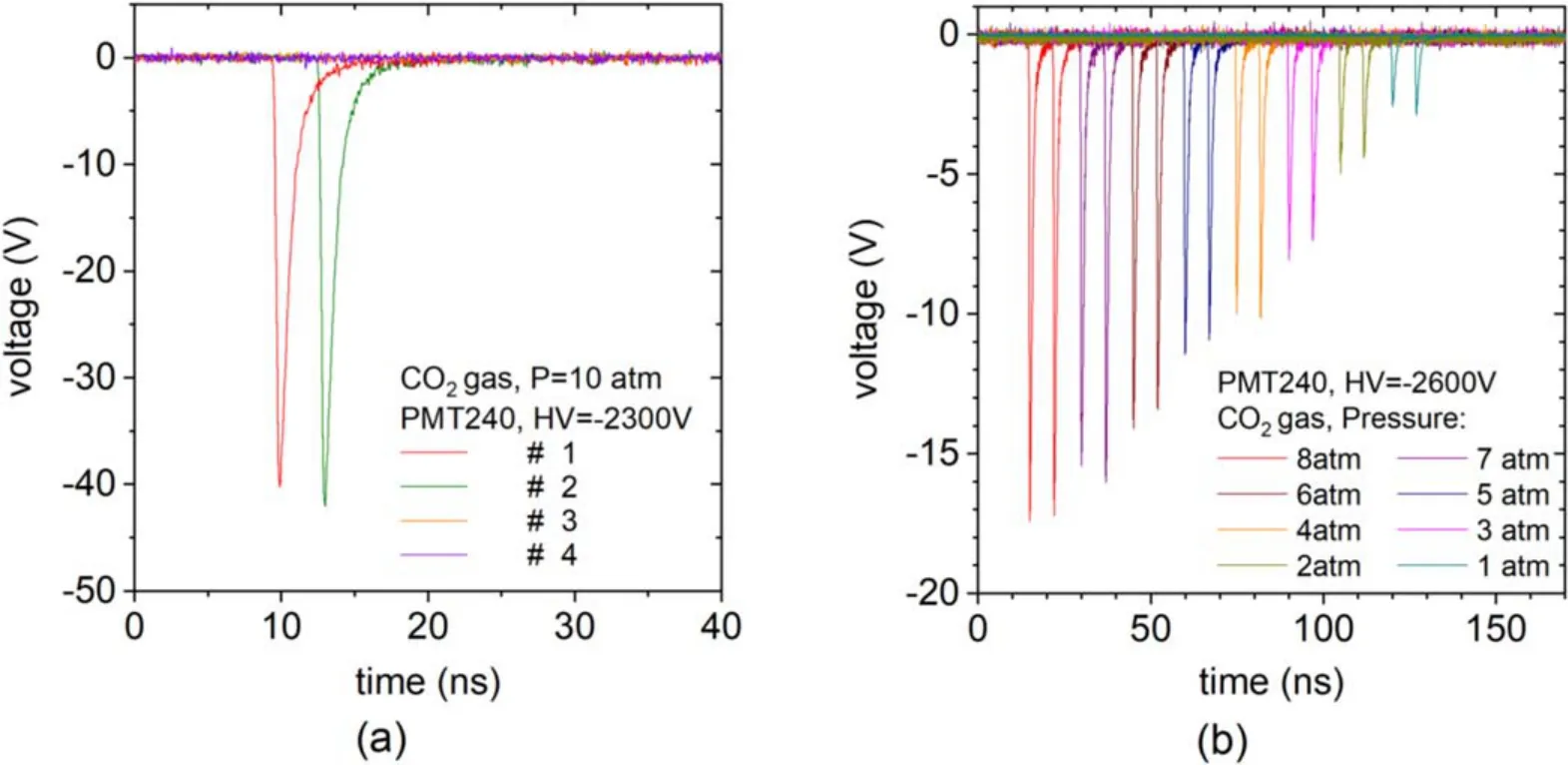
Figure 8.(a) Measured signals recorded by the PMT240 photomultiplier tube.The red solid line and the olive solid line are the measured Cherenkov light signals(the time interval of 3 ns is added to separate the two signals from each other),and the orange solid line and the violet solid line are the measured background signals for contrast when an opaque foil inserted between the fused silica pressure window and the photomultiplier tube.(b)The intensity of the Cherenkov light signal measured at different CO2 pressures.In this figure,the time interval of 7.5 ns is added sequentially for each shot in order to contrast of the signal intensity conveniently.
The intensity of Cherenkov photons at different gas pressures are not only related to the conversion efficiency of Cherenkov photons, but also to the changes in photon collection efficiency caused by the spatial distribution and angular distribution of Cherenkov photons.When the CO2gas pressure is set to 8 atm, the radial distribution of Cherenkov photons reaching the off-axis parabolic reflector within an off-axis angle of 15° is shown in figure 9(a), and the angular distribution of Cherenkov photons within the radial rings at an interval of 0.5 cm is shown in figure 9(b).The radial distribution and angular distribution of Cherenkov photons were input into the optical simulation model by the optical tracing software LightTools, in which the size of the optical receiving surface was set to 40 mm in diameter.
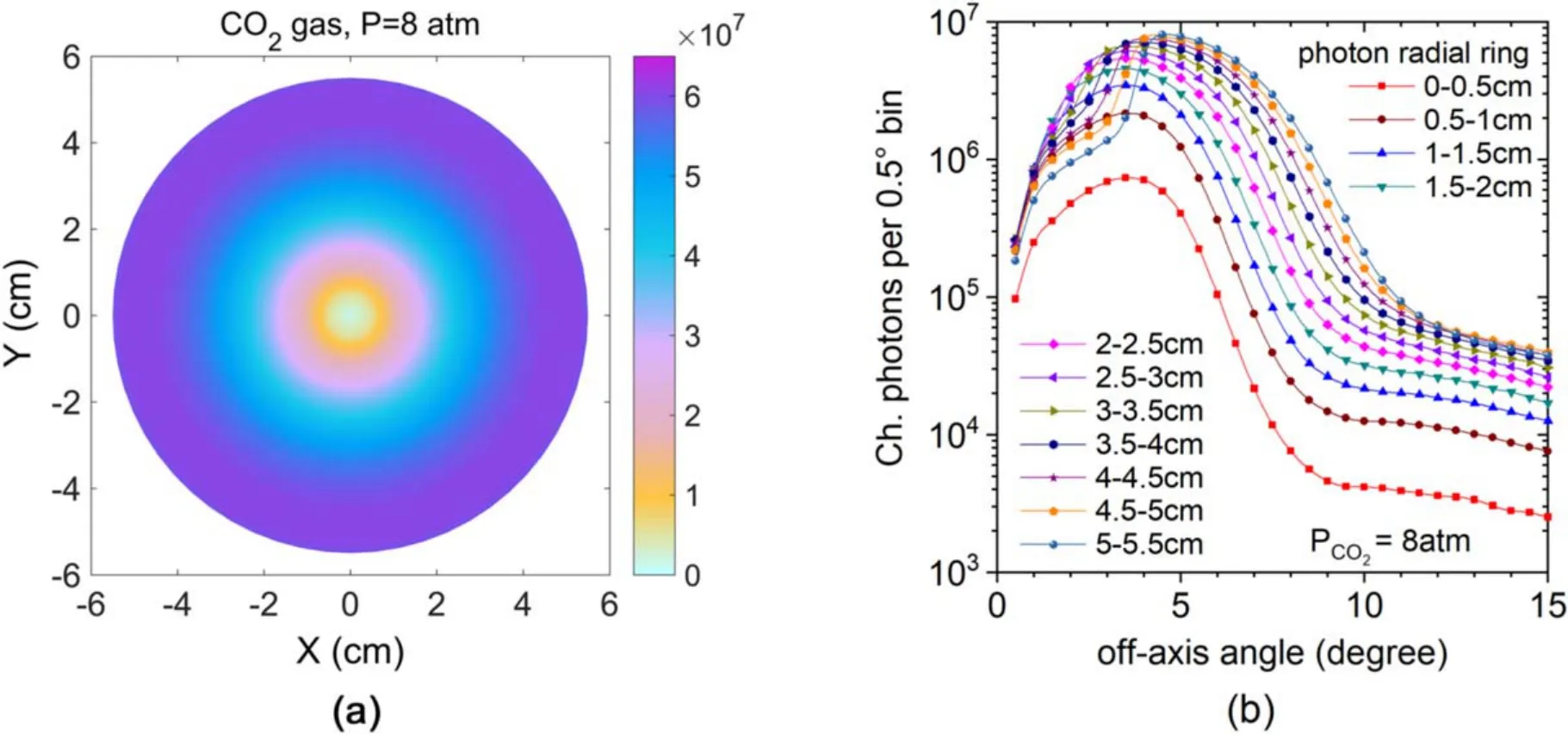
Figure 9.The simulation result of Cherenkov photons reaching the off-axis parabolic reflector within an off-axis angle of 15°at 8 atm CO2 pressure.(a) Photons radial distribution.(b) Angular distribution of photons within the radial rings at an interval of 0.5 cm.
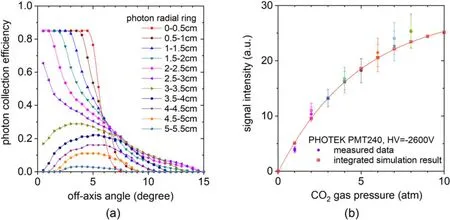
Figure 10.(a) Optical simulation results of photon collection efficiency at different angles within the radial rings.(b) Measured Cherenkov signal intensity and integrated simulation results at different CO2 gas pressures.The data with solid dots and that with hollow dots aremeasured repeatedly at the same gas pressure.
The optical efficiencies of the off-axis parabolic reflector in collecting photons at different angles within the radial rings are simulated, as shown in figure 10(a).When the CO2pressure increased from 1 to 8 atm,the radial distributions and the angular distributions of Cherenkov photons were obtained using the Monte Carlo simulation model, and the photon collection efficiency at different gas pressures was given.The integrated intensity of collected Cherenkov photons was obtained by coupling the simulated photon conversion efficiency and the photon collection efficiency of the off-axis parabolic reflector.The measured Cherenkov light signals changing with CO2gas pressure and the integrated simulation results are shown in figure 10(b).The errors of measured data are about 12% mainly caused by the unstable electron beams accelerated by femtosecond laser wakefield in the testing experiments.The experimental results were basically in agreement with, but not absolutely correlated with, the simulation results,because the Cherenkov photon attenuation factor of the optical absorptive filter NE2R10B used for experiment was not calibrated.
5.Conclusions
A simulation model of OprGCD was built using the Geant4 Monte Carlo simulation toolkit, and the optimal design was given.The performance test of this system was conducted by using the femtosecond laser-wakefield-accelerated electron beams.Cherenkov light signals with high SNR were obtained, and the intensity of Cherenkov light signals changing with the CO2pressure was studied.Meanwhile, the Monte Carlo simulation had been partially validated for the OprGCD system by predicting the changes in the intensity of Cherenkov light signals at different gas pressures.Further work is required for an absolute calibration of the optical absorptive filter in order to give the measured intensity of Cherenkov photons accurately, and the gamma-ray Cherenkov detector simulation model will be verified using the experimental results.
Femtosecond laser-wakefield-accelerated electron beams provide a platform for performance study of the gamma-ray Cherenkov detectors.The design and performance study on such detector lay the foundation for the application of fusion gamma diagnostics in large laser facilities of China.The gamma-ray Cherenkov detectors used in large laser facilities need to have higher temporal response, and such temporal response will be further improved when faster phototubes are used in photon recording subassemblies.
Acknowledgments
The authors would like to thank the staff of the SILEX-I laser facility for their cooperation in this work.Thanks to Professor Xuan LUO from Institute of Solid State Physics, Chinese Academy of Sciences for his kind help and useful suggestions in writing this paper.
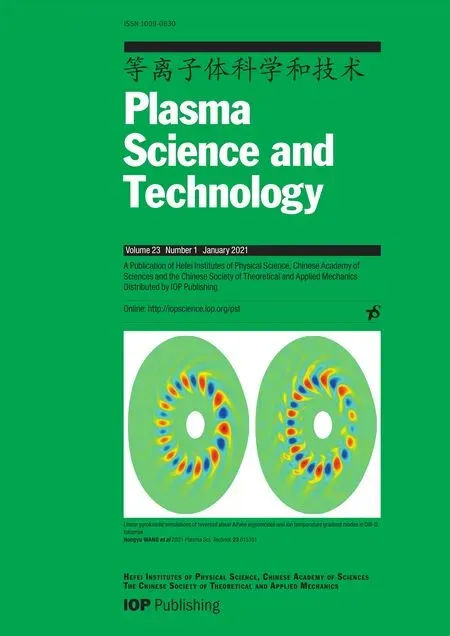 Plasma Science and Technology2021年1期
Plasma Science and Technology2021年1期
- Plasma Science and Technology的其它文章
- Effects of packing particles on the partial discharge behavior and the electrical characterization of oxygen PBRs
- Energy dissipation and power deposition of electromagnetic waves in the plasma sheath
- Modification of exposure conditions by the magnetic field configuration in helicon antenna-excited helium plasma
- Theoretical model and experimental investigation optically triggered hollowcathode discharge formation
- Electron population properties with different energies in a helicon plasma source
- Linear gyrokinetic simulations of reversed shear Alfvén eigenmodes and ion temperature gradient modes in DIII-D tokamak
